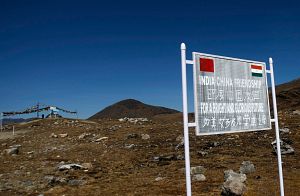Starting in June, a tiny piece of strategically important and until-now obscure Himalayan territory sitting at the intersection of India, China, and Bhutan became the site of the one of the most serious border standoffs between New Delhi and Beijing in three decades. As of July 12, 2017, the standoff continues, with no end in sight. Scores — potentially hundreds — of Indian Army and Chinese People’s Liberation Army troops remain at an impasse near the Doka La pass in Doklam. Nearly one month after the standoff began, details about the geography of the area and the motivations of all three governments involved remain murky.
In the meantime, rhetoric in India and China has reached a slow simmer, with op-ed writers and commentators taking pains to highlight the other side’s transgressions. On both sides, suggestions of a new war or military skirmish between the two nuclear-armed Asian neighbors, both with populations in excess of 1 billion, are slowly becoming less taboo, highlighting the potential for serious escalation. If anything is clear about this crisis, it’s that the stakes are high. Unfortunately, nearly everything else about the terrain under contention and the events that initiated the standoff remains unclear.
This marks the first in a series of articles I’ll be authoring for The Diplomat outlining the various elements of this standoff. Though I’ll elaborate in successive articles, the dispute began in early June when Chinese People’s Liberation Army (PLA) engineers began constructing a road near the Indian border on a piece of territory disputed between China and Bhutan. India, perceiving this as an unacceptable change to the status quo with potentially serious strategic ramifications, crossed a settled and undisputed international border with its troops to block the PLA contingent from proceeding. The Chinese government was apoplectic about what it saw as an Indian incursion across a settled border into Chinese territory (in reality, disputed with Bhutan) and has given an ultimatum to New Delhi that no diplomatic solution can be found until Indian troops unilaterally withdraw from what Beijing sees as Chinese territory. India, in the meantime, is not budging. Both sides are gridlocked and tensions are rising.
This first installation in this series focuses on outlining what is arguably the fundamental matter in understanding what’s at stake and where this standoff even originated: the political geography of the Doklam triboundary dispute.
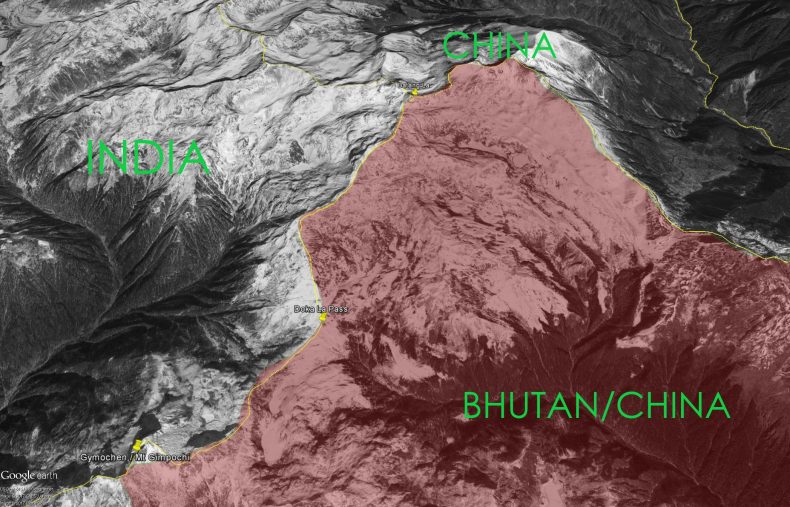
The Doklam triboundary region. The area shaded in red is disputed between Bhutan and China. Source: Google Maps.
The best place to begin in trying to understand the situation between India, China, and Bhutan at Doklam is the an overview of the terrain in question, which had never made international headlines before this summer. First of all, the area in question — shown shaded in red in the map above — is not what most maps will label as the Doklam plateau, a better-known piece of disputed territory between Bhutan, a tiny Himalayan kingdom of less than a million people, and China. Instead, the area is perhaps best disambiguated from the plateau by referring to it as the Doklam triboundary or Doklam triborder area (also sometimes known as the Dolam Plateau). At the core of the dispute is the question of where the final triboundary point — the point at which India, China, and Bhutan meet — lies.
What’s critical in this scenario is the recognition that the India-China border in this area, where Sikkim meets the Chumbi valley, a dagger-like protrusion from southern Tibet, is settled and undisputed between the two countries. Both India and China agree that while they have disputed borders in Arunachal Pradesh and in Kashmir, the Sikkim sector border has long been a settled matter. Thus, this standoff is not and never was about a disputed border between India and China. This, in the Chinese view, makes it different from recent high-profile border incidents between the two countries in 2013 at Depsang and in 2014 at Chumar, both sites near their mutually recognized Line of Actual Control. This also helps explain why the Chinese reaction to this incident has been so exceptionally negative, with state mouthpiece the People’s Daily alluding to a front page editorial covering the events of 1962, when China defeated India in a major war at their Himalayan border.
Despite the tense situation between India and China, the border dispute in question that complicates the triboundary question is between Bhutan and China. The two countries, who do not have official diplomatic ties, have held 24 rounds of diplomatic talks over their various border disputes. (Bhutan has the distinction of being the sole country to neighbor China that doesn’t have normal diplomatic ties with Beijing.) Despite these long-running talks, the Doklam triboundary area dispute had been one of the lower-profile boundary disputes between Thimphu and Beijing. Both countries have given relative priority to other disputed sectors in their talks, including the Doklam Plateau, which sits farther north, sandwiched between the Chumbi Valley and the rest of Bhutan.
The Bhutan-China border, once settled in this sector, would meet the Indian border at a perpendicular angle, east-to-west, and finalize the triboundary point between the three countries. Bhutan claims that the triboundary point lies at a location known as Batang-la, some four kilometers north of the Doka La pass where the standoff between Indian and Chinese troops is ongoing. China, meanwhile, claims the triboundary point at Mount Gipmochi or Gyemochen, a point some two-and-a-half kilometers south of the Doka La pass. Mount Gipmochi marks the terminus at the Indian border of what New Delhi regards as a strategic redline: the Jampheri ridge, which marks start of the descent into the foothills of southwestern Bhutan that then lead into the strategically vital Siliguri Corridor. Despite India’s fortification of this area over the years, the Corridor is perceived as an immense strategic vulnerability.
India has long supported Bhutan’s claim and, according to a release by the Indian Ministry of External Affairs on the ongoing standoff, reached an agreement in 2012 with China that existing “tri-junction boundary points” between the two countries and any third party would be “finalized in consultation with the concerned countries.” That agreement is not public, but, in a recent interview, former Indian Foreign Secretary Shivshankar Menon referred to the agreement as a “broad understanding.” The Chinese Foreign Ministry, in its various statements on the standoff, has not made any reference to the 2012 agreement since the standoff began.
As with so many Himalayan border questions, the outstanding triboundary question in the Doklam sector appears to be a relic of 19th century survey work that informed an 1890 convention between British India and the Qing dynasty. Article I of the “Convention Between Great Britain and China Relating to Sikkim and Tibet” is the cornerstone of China’s claim. The convention settled the border between the then-independent kingdom of Sikkim, which was a British protectorate, and Tibet. In successive statements on the ongoing standoff at Doklam, various Chinese Foreign Ministry spokespeople have relied on this convention as the basis for China’s claim.
The text in Article I of this convention has been the subject of intense hermeneutics in the aftermath of the dispute:
The boundary of Sikkim and Tibet shall be the crest of the mountain range separating the waters flowing into the Sikkim Teesta and its affluents from the waters flowing into the Tibetan Mochu and northwards into other rivers of Tibet. The line commences at Mount Gimpochi on the Bhutan frontier, and follows the above-mentioned water-parting to the point where it meets Nipal territory.
The Chinese Foreign Ministry has recited these lines to support its claim that Mount Gipmochi, the aforementioned point some two-and-a-half kilometers south of the Doka La site, is the rightful triboundary point. Beijing has argued in addition that independent India’s first prime minister, Jawaharlal Nehru, affirmed his support for this interpretation of the border in a 1959 letter to the People’s Republic of China’s first premier, Zhou Enlai.
Beijing takes this to mean that the convention remained in force under India as the successor state to British India and denoted the triboundary point, even if Bhutan was not a party to the convention. Beijing also justifies its claim to the Doklam region more broadly by evoking the “indisputable fact” that “Doklam has always been part of China’s territory and under its effective jurisdiction” — language that may sound familiar to readers who track Chinese claims in the South China Sea, for instance. To explain its claim, the Chinese Foreign Ministry released its own map of the area, shown below. The blue arrow shows the location of the Indian Army crossing and the mountain shown at the trijunction point is Mount Gipmochi. (Neither the Indian nor Bhutanese governments have released authoritative maps highlighting their interpretation of the triboundary point.)
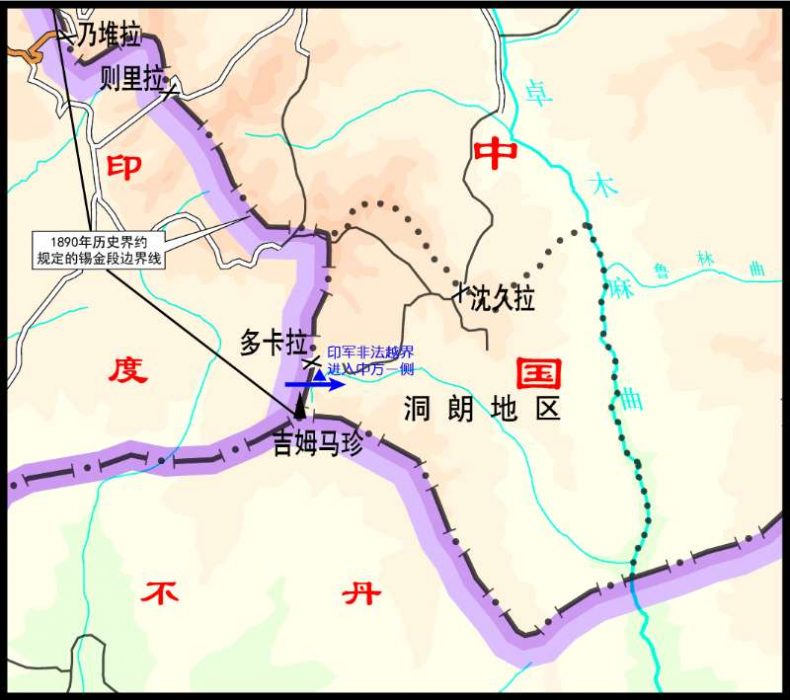
A Chinese Foreign Ministry map of the disputed region. Source: Chinese Foreign Ministry.
Complicating matters, however, the Indian interpretation of the 1890 convention differs from the Chinese one in an important way and appears to be supported by geographic realities. The demarcation in the convention is similar to several other Himalayan border delimitations in the late-19th and early-20th century, which relied on what’s known as the “watershed principle.” Effectively the border between British India and China was to be decided on the basis of the highest continuous mountain ridge line — the “crest of the mountain range” in the convention above refers to this principle.
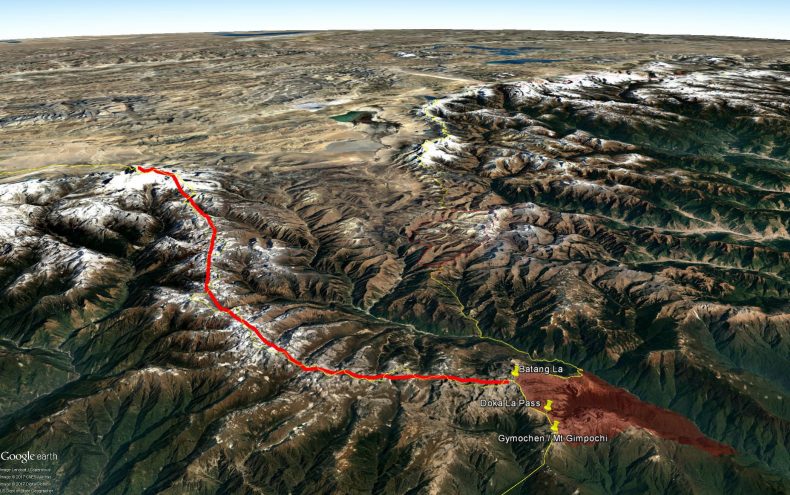
An overview of the crest of the mountain range linking Batang-la to Nepal, which is referenced in the 1890 Anglo-Chinese convention. Source: Google Maps.
In the case of Doklam, there is indeed a continuous ridgeline that runs from the current triboundary point between India, Nepal, and China to the area at the center of the current standoff. However, as the thick red line on the map above demonstrates, the ridge line appears to terminate at Batang-la, the point India and Bhutan claim as the triboundary point, even though the convention’s text explicitly says “Mount Gipmochi.” Effectively, this puts the first sentence of the convention’s first article in conflict with the second and is likely an artifact of poor survey work in the late-19th century. Moreover, according to historian Claude Arpi, who specializes in the Himalayan region, Sikkimese records even note that Gipmochi is Batang-la, adding to the confusion.
But here we are, more than 120 years after the convention, with Indian and Chinese troops facing off at the Doklam triboundary area. As fascinating as the geographic contours of this crisis might be and as important as they may be to understanding the stakes, there is a slim chance that New Delhi and Beijing will settle this by coming to a mutual understanding about the shoddy survey work of the late-19th century cartographers who informed the Anglo-Chinese convention.
While the Indian and Chinese positions have gotten the most attention and scrutiny in either country’s media, Bhutan’s position on the dispute remains under-discussed. The Bhutanese Foreign Ministry released a statement in late June clarifying its position. The statement provided an interesting third-party view of the Doklam standoff and did not mention India at all. It offered the following assessment of what transpired in mid June: “On 16th June 2017, the Chinese Army started constructing a motorable road from Dokola in the Doklam area towards the Bhutan Army camp at Zompelri” (emphasis added).
India and Bhutan have a special relationship, with New Delhi exercising considerable influence over the country’s foreign and defense policy historically and to this day; the two countries’ 1949 treaty of friendship was updated in 2007 by the two sides to give Thimphu additional autonomy in its foreign and security policy. The updated treaty, nevertheless, notes the following: “Neither government shall allow the use of its territory for activities harmful to the national security and interest of the other.”
The Bhutanese statement on the events of June 16 and the ensuing fallout, if taken at face value, is clarifying in a way that official Chinese and Indian statements haven’t been about the specific location of the alleged PLA construction work that sparked the Indian Army to respond. First, the Bhutanese note that the construction began from the Doko La pass. Looking at commercial satellite imagery, one can see that the Chinese had maintained an at least partially motorable track to within 50 meters of the Doko La crossing since at least as recently as 2005, though other accounts put the PLA’s path-building activities in the area as starting in the late 1980s. Whatever happened in mid June, it likely involved plans to add a southward motorable extension to that road, but evidence of this kind of work is not visible in more recent imagery. This is corroborated by more recent reporting out of India as well.
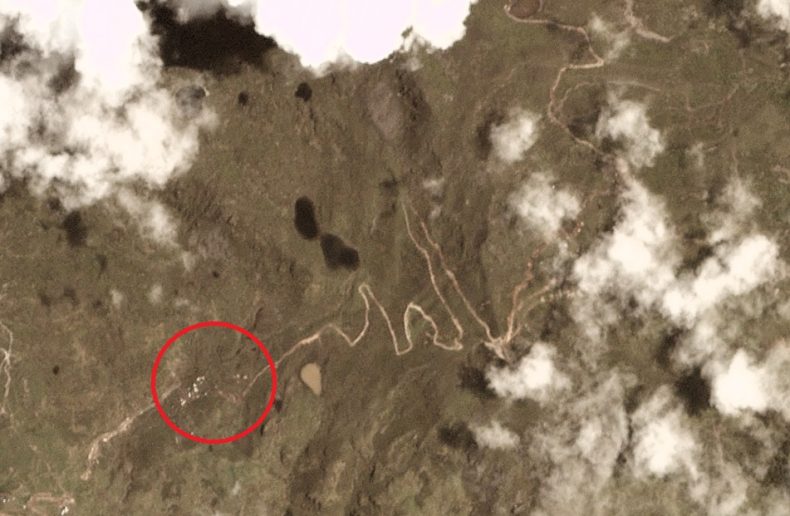
June 23, 2017 imagery showing possible PLA structures near the Doko La terminus of the track, which has existed since at least 2005. Source: Planet Labs Inc.
Satellite imagery from June 23 (above) shows signatures of possible human structures near the road, but does not show any clear evidence of successful PLA construction of a motorable road. More recent satellite imagery suggests that the track to Doko La may have also previously improved prior to June 2017, but that assessment is inconclusive.
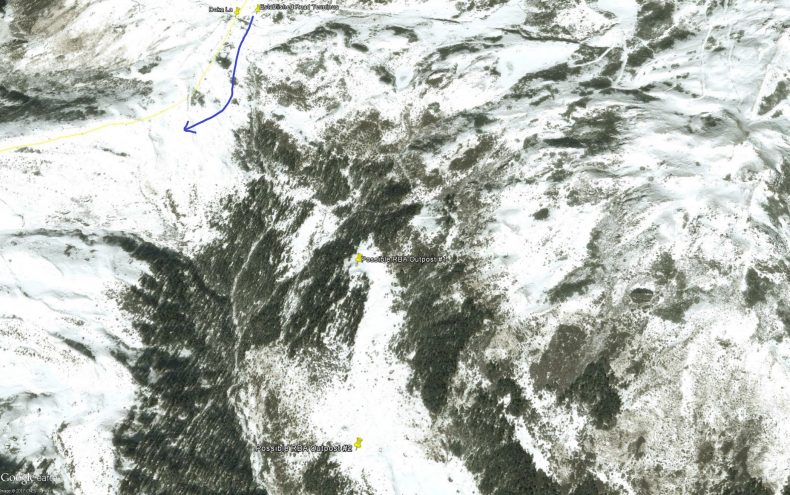
An overview of the disputed area east of Doko La, highlighting possible Royal Bhutanese Army camps in relation to the Chinese road. Source: Google Earth.
The Zompelri (also romanized as Jampheri) camp of the Royal Bhutan Army is not labeled on any publicly available maps, but a few structures (labeled above) visible in commercial satellite imagery, about 1 kilometer south east of the Chinese road, are possible candidates for the location of these camps as they are the only significant human structures south of the Chinese road and east of the Indian border. These structures may be where the “Royal Bhutan Army patrol” that the Indian statement referred to originated. The Indian statement noted that this patrol tried to “dissuade [the Chinese] from this unilateral activity.”
Given that these possible camps are located about 90 meters downhill from the location of the alleged Chinese construction, it may be the case that the Bhutanese patrol encountered PLA troops after heading uphill to investigate possible construction activity near Doko La. India’s statement on the events of June 16 noted that “In coordination with the RGOB, Indian personnel, who were present at general area Doka La, approached the Chinese construction party and urged them to desist from changing the status quo.” The blue arrow in Map 5 above shows the likely direction of China’s alleged road construction.
Given India’s privileged defense relationship with Bhutan and even permanent military presence in parts of western Bhutan, the act of Indian troops crossing the international boundary with the consent of the Bhutanese government in a collective security context also underscores India’s perception of why its actions weren’t the serious transgression against international law that the Chinese allege. However, given India’s concerns about a unilateral Chinese change to the status quo, it should be noted that satellite imagery between 2005 and 2016 reveals substantive Indian improvements on its side of the border (the key difference being that Indian improvements took place in undisputedly Indian territory).
The above catalogue of the geographic details and the chronology of events in mid June may seem detailed, but fails to answer several questions about the origins of this standoff. For one, the motivations of both the PLA in beginning road improvements over a long-established track in June 2017 and the Indian Army’s resolve to cross the settled boundary to interdict them are not explained adequately by geographic factors alone. Given that both the Indian and Chinese governments have carefully managed their public messaging and prevented any substantial leaks of the on-the-ground situation to the media, answering these questions will require looking beyond what is visible on maps, in satellite imagery, and in government statements.
Ultimately, the origins of this standoff are rooted in simmering tensions about where India and China stand as rivalrous Asian powers in the second decade of the 21st century and realpolitik considerations in both New Delhi and Beijing. This is where matters diverge from the geographic and historical details outlined above. Not only are Chinese and Indian perceptions of facts on the ground and the status quo widely divergent, but a series of developments in recent years have underlined that their paths in Asia are destined to diverge. This partly explains Beijing’s brinksmanship and New Delhi’s resolve to stand its ground in Doklam. With neither side seeing a face-saving off-ramp option, the potential for escalation remains high. I’ll address these factors and their relationship to the ongoing standoff in a second installation for The Diplomat.
Ankit Panda is a senior editor at The Diplomat, where he writes on security, politics, and economics in the Asia-Pacific region. Follow him on Twitter at @nktpnd.













